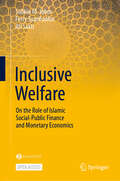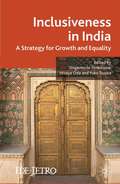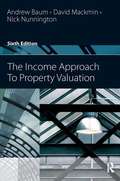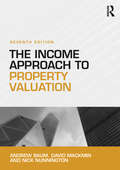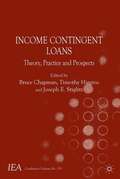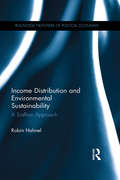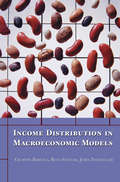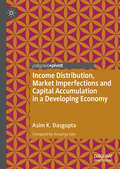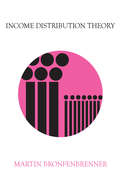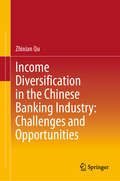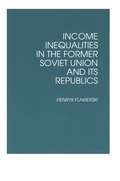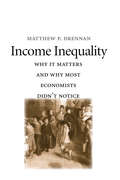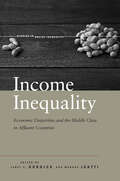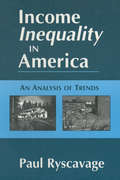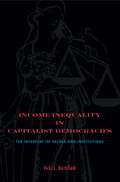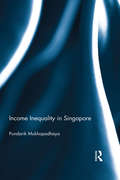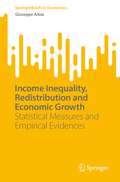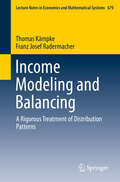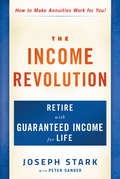- Table View
- List View
Inclusive Welfare: On the Role of Islamic Social-Public Finance and Monetary Economics
by Solikin M. Juhro Ferry Syarifuddin Ali SaktiThis open access book serves to spur further development of Islamic economic and financial concepts and practices, particularly in terms of Islamic social-public finance and Islamic monetary policy support. The book has a number of objectives across different aspects. From an academic perspective, the book aims to foster frontier thinking and concepts that advance scientific ideas and teaching materials relating to the Islamic financial system, particularly the role of Islamic social-public finance and Islamic monetary economics. From a policy perspective, the book explores and develops discussions that support public policy innovation, thereby providing comprehensive understanding of policy theories and practices in the Islamic financial system. From a practical perspective, the book is expected to contribute by increasing knowledge and understanding concerning the application and scope of the Islamic economic system. This will confer various benefits to the readers.
Inclusiveness in India
by Shigemochi Hirashima Hisaya Oda Yuko TsujitaThis bookexamines inclusive growth in a range of social and economic areas in India, includingphysical infrastructure, vulnerable sections of the population and underdeveloped states. It provides acomprehensivestudy of disparity and deepens insight into understanding processes of economic and social development. "
The Income Approach to Property Valuation
by Nick Nunnington Andrew Baum David MackminThis classic text has been updated to meet the needs of today's students. It has been revised in line with the 2011 seventh edition of the RICS Valuation Standards and covers the latest valuation techniques including the important area of investment appraisals. It will help readers understand the complex world of property valuation, in particular: how to analyze market rents and sales prices to derive market evidence to support an opinion of market value the investment method of valuation and how it's applied in practice how specific legal factors can impact on market value when they interfere with market forces what the market and the profession may consider to be the 'right' methodology in today's market place how to use spreadsheets in valuation. This new edition places a particular emphasis on investment valuations and the impact of landlord and tenant relationships on value. The text has always been well regarded for its clear explanations of the maths behind valuations, and practical examples are provided to illustrate the valuation techniques used today for property investments, property developments and properties valued with reference to their business profits.
The Income Approach to Property Valuation
by Nick Nunnington Andrew Baum David MackminA classic textbook that has guided generations of students through the intricacies of property valuation, The Income Approach to Property Valuation remains a keen favourite amongst students and teachers alike. This new edition has been thoroughly revised and updated to meet the increasingly international perspectives of modern Real Estate students. The links between theory and practice are clearly demonstrated throughout, with a range of new international case studies and practice-based examples. The Income Approach to Property Valuation teaches readers: how to analyse market rents and sales prices to derive market evidence to support an opinion of market value; the investment method of valuation and how it is applied in practice; how specific legal factors can impact on market value when they interfere with market forces; what the market and the profession may consider to be the 'right' methodology in today's market place; and how to use spreadsheets in valuation. This extensively revised new edition is perfect both for students on Real Estate courses worldwide and for professional candidates working towards their final assessment of professional competence (APC) for the Royal Institution of Chartered Surveyors, needing to demonstrate a valuation competence at levels 2 and 3.
Income Contingent Loans: Theory, Practice, and Prospects (International Economic Association #153)
by Bruce Chapman Timothy Higgins Joseph E. StiglitzThis study explores the prospect of the application of the basic principles of ICL into many other potential areas of social and economic policy. Using case studies it evaluates previously implemented ICL schemes where interest rate subsidies are usually the norm, and questions the merits of this approach.
Income Distribution and Environmental Sustainability: A Sraffian Approach (Routledge Frontiers of Political Economy)
by Robin HahnelAny economics that does not deal forthrightly with economic inequality is no longer suitable for the twenty-first century. Similarly, any economics which does not provide a coherent way to integrate environmental sustainability into economic analysis will fail to command allegiance in the century ahead. This book demonstrates how the Sraffian framework provides important advantages in both areas. Divided into three chapters, Income Distribution and Environmental Sustainability provides a rigorous exposition of Sraffian theory emphasizing what it means for the economy to be productive, extends Sraffian theory to address environmental sustainability, and adds a normative theory of income distribution to Sraffa’s positive theory. In Chapter 1, a rigorous version of the basic Sraffa model is presented which focuses on what it means for the economy to be capable of producing a physical surplus, explains the origin of profits, and shows how to measure changes in overall labor productivity resulting from any technical change. In Chapter 2, the basic model is extended to incorporate primary inputs from the natural environment, rigorously measure changes in environmental throughput efficiency, and establish sufficient conditions for environmental sustainability. In Chapter 3, an explicit "normative" theory of economic justice is elaborated which is a natural extension of Sraffa’s "positive" theory of income determination and consistent with modern egalitarian literature on distributive justice. This book is of interest to academics and students who study political economy, economic theory, and philosophy, as well as those interested in the work of Piero Sraffa.
Income Distribution Dynamics of Economic Systems: An Econophysical Approach
by Marcelo Byrro RibeiroEconophysics has been used to study a range of economic and financial systems. This book uses the econophysical perspective to focus on the income distributive dynamics of economic systems. It focuses on the empirical characterization and dynamics of income distribution and its related quantities from the epistemological and practical perspectives of contemporary physics. Several income distribution functions are presented which fit income data and results obtained by statistical physicists on the income distribution problem. The book discusses two separate research traditions: the statistical physics approach, and the approach based on non-linear trade cycle models of macroeconomic dynamics. Several models of distributive dynamics based on the latter approach are presented, connecting the studies by physicists on distributive dynamics with the recent literature by economists on income inequality. As econophysics is such an interdisciplinary field, this book will be of interest to physicists, economists, statisticians and applied mathematicians.
Income Distribution in Less Developed Countries
by R. M. SundrumThis is a major book in a key area of development economics. It gives a comprehensive survey of the link between income distribution and the growth of national income, bringing out major patterns and trends, and concluding that there is still considerable scope for growth with equity in LDCs.
Income Distribution in Macroeconomic Models
by Giuseppe Bertola Reto Foellmi Josef ZweimüllerThis book looks at the distribution of income and wealth and the effects that this has on the macroeconomy, and vice versa. Is a more equal distribution of income beneficial or harmful for macroeconomic growth, and how does the distribution of wealth evolve in a market economy? Taking stock of results and methods developed in the context of the 1990s revival of growth theory, the authors focus on capital accumulation and long-run growth. They show how rigorous, optimization-based technical tools can be applied, beyond the representative-agent framework of analysis, to account for realistic market imperfections and for political-economic interactions. The treatment is thorough, yet accessible to students and nonspecialist economists, and it offers specialist readers a wide-ranging and innovative treatment of an increasingly important research field. The book follows a single analytical thread through a series of different growth models, allowing readers to appreciate their structure and crucial assumptions. This is particularly useful at a time when the literature on income distribution and growth has developed quickly and in several different directions, becoming difficult to overview.
Income Distribution, Market Imperfections and Capital Accumulation in a Developing Economy
by Asim K. DasguptaThe book explains the problem of insufficient capital accumulation and growth in a less developed country. In conventional analyses, such explanations are often found exogenised in terms of factors such as socio-cultural attitudes towards saving and investment, irrationality of peasant behaviour, technological aspects of externalities and demographic parameters. This book provides an alternative explanation in terms of distribution of income and assets. Focusing on the agricultural sector of a developing economy, it describes how this approach can be extended to cover the industrial sector as well. Further, it develops a model that is then used to analyse the specific problem of capital accumulation in agriculture.
Income Distribution Theory
by Martin BronfenbrennerThis is a well-grounded restatement, defense, and development of the theory of income distribution in both its micro- and macroeconomic aspects. The author, an authority in the field who has spent many years developing the ideas in this book, balances neoclassical theories with Keynesian and ""radical"" approaches. He considers income distribution theory in terms of ideology, statistics, micro- and macroeconomics, income policies, and the poverty problem. The result is a distinctive and comprehensive treatment of a subject that has polarized many economists over many decades. Bronfenbrenner reacts against conventional theories that concentrate on output markets, virtually ignoring input prices. He also opposes the brand of institutionalism that regards ""democratic business unionism"" as an American institution that can do no wrong. Overall, Bronfenbrenner presents an eclectic defense of a ""traditional"" theory of economics that has been under attack from rival viewpoints with insufficient rebuttal, and that proves to be a powerful tool of analysis in dealing with this subject. The book is organized into three main parts: an ideological and statistical personal introduction to income distribution, microeconomic distribution theory, and macroeconomic distribution theory. A final chapter considers incomes policies, with a rather skeptical view of the prospects for political control of income distribution within a basically free economy. The manuscript has been widely used and class tested over the past thirty-five years. The book will be useful to professional economists. It may be used as a basic text in courses on income distribution and as a supplementary text in microeconomic theory.
Income Diversification in the Chinese Banking Industry: Challenges and Opportunities
by Zhixian QuThis book provides an overview of the historical financial reforms and regulatory changes in China, highlighting the background to and causes of changes in the income structure of China's banks. It also investigates ongoing concerns with regard to banking diversification in China, and its consequences, amid the global trend of banks’ shift to non-traditional businesses. Focusing on three critical aspects of bank-income diversification, namely the effects on profitability, risk level, and efficiency, it employs the concept of systemically important banks, which describes the scale and degree of influence a bank has in global and domestic financial markets. More importantly, rather than replicating techniques employed in the research on developed markets, it applies several improved methodologies to address bank diversification in the specific context created by China’s unique institutional background and data characteristics, such as GMM-type threshold models and stochastic frontier analysis with the within maximum likelihood estimation. Shedding new light on the current status of income diversification in the Chinese banking sector, this book is a valuable resource for readers in fields such as banking and financial stability. It will also help banking professionals and financial regulatory authorities to better understand the reform of China's financial industry and the future direction of banking.
Income Inequalities in the Former Soviet Union and Its Republics
by Henryk FlakierskiThis study analyses the newly available statistical evidence on income distribution in the former Soviet Union both by social group and by republic, and considers the significance of inequalities as a factor contributing to the demise of the Communist regime. Among the topics covered are wage distribution (interbranch and skill differentials and distribution in terms of gender, education, and age), income distribution for the former USSR as a whole, and wage and income distribution patterns for each republic, with analysis of regional differences.
Income Inequality
by Matthew P. DrennanPrevailing economic theory attributes the 2008 crash and the Great Recession that followed to low interest rates, relaxed borrowing standards, and the housing price bubble. After careful analyses of statistical evidence, however, Matthew Drennan discovered that income inequality was the decisive factor behind the crisis. Pressured to keep up consumption in the face of flat or declining incomes, Americans leveraged their home equity to take on excessive debt. The collapse of the housing market left this debt unsupported, causing a domino effect throughout the economy. Drennan also found startling similarities in consumer behavior in the years leading to both the Great Depression and the Great Recession. Offering an economic explanation of a phenomenon described by prominent observers including Thomas Piketty, Jacob Hacker, Robert Kuttner, Paul Krugman, and Joseph Stiglitz, Drennan's evenhanded analysis disproves dominant theories of consumption and draws much-needed attention to the persisting problem of income inequality.
Income Inequality: Economic Disparities and the Middle Class in Affluent Countries
by Janet C. Gornick Markus JänttiThis state-of-the-art volume presents comparative, empirical research on a topic that has long preoccupied scholars, politicians, and everyday citizens: economic inequality. While income and wealth inequality across all populations is the primary focus, the contributions to this book pay special attention to the middle class, a segment often not addressed in inequality literature. The research also casts important light on how economic inequality affects and is affected by gender disparities, labor markets, institutions, and politics. Written by leading scholars in the field of economic inequality, all 17 chapters draw on microdata from the databases of LIS, an esteemed cross-national data center based in Luxembourg. Using LIS data to structure a comparative approach, the contributors paint a complex portrait of inequality across affluent countries at the beginning of the 21st century. The volume also trail-blazes new research into inequality in countries newly entering the LIS databases, including Japan, Iceland, India, and South Africa.
Income Inequality and the CEO Pay Ratio at TJX Cos
by Akari Furukawa Ethan RouenTJX Companies reported a CEO pay ratio of 1,596-to-1 in 2019, leaving board chair Carol Meyrowitz with a host of questions about whether, and how, she could take action to address concerns raised by having one of the highest pay ratios in the S&P 500. As a retail company, TJX had 270,000 employees, many making about $10 an hour. On the other hand, CEO Ernie Hermann made $19 million in 2019 as he successfully steered the company through the tumultuous retail environment. Meant to be read in tandem with the research note "Income Inequity and Income Inequality," this case examines the current disclosures companies make related to income inequality and asks whether they are sufficient or how they can be improved. This discussion around disclosure also provides opportunities to examine the role of the firm in creating income inequality and how the firm should balance its obligations to shareholders and employees when those obligations may be in conflict. Lastly, the case and note address the CEO pay setting process to give students an understanding of how pay is determined.
Income Inequality in America: An Analysis of Trends
by Paul RyscavageWhat is income inequality? How is it measured? Is the middle class really declining? How does it relate to poverty? How long has inequality been rising in the US? Have there been other periods in history when income differences were as large as they are today? What are the causes of growing income and wage inequality? The author addresses these and other conceptual issues in eight carefully reasoned and clearly presented chapters. Concluding with an analysis and comparison of trends in wage inequality in other developed countries, he asks the final speculative question: How much more growth in inequality can our society withstand?
Income Inequality in Capitalist Democracies: The Interplay of Values and Institutions
by Vicki L. BirchfieldThere has been much concern about rising levels of income inequality in the societies of advanced industrial democracies. Commentators have attributed this increase to the impact of globalization, the decline of the welfare state, or the erosion of the power of labor unions and their allies among left-wing political parties. But little attention has been paid to variations among these countries in the degree of inequality. This is the subject that Vicki Birchfield tackles in this ambitious book. Differences in political institutions have been seen by political scientists as one likely explanation, but Birchfield shows institutional variation to be only one part of the story. Deploying an original conceptualization of political economy as applied democratic theory, she makes the compelling case that cultural values—particularly citizens' attitudes about social justice and about the proper roles of the market and the state—need to be factored into any account that will provide an adequate explanation for the observable patterns. To support her argument, she brings to bear both multivariate statistical analyses and historical comparative case studies, making this book a model for how quantitative and qualitative research can be effectively combined to produce more complete explanations of political and socioeconomic phenomena.
Income Inequality in Singapore: Trends And Policy Implications (Routledge Studies In The Modern World Economy Ser.)
by Pundarik MukhopadhayaThe World Bank, 1993 conferred on Singapore the status of ‘tiger economy’ because of its two miraculous characteristics: high growth and reduced income inequality. Expansion of educational provision is one of the major policies the Government of Singapore followed since 1975 particularly to enrich the human capital endowment of the country which has been crucial to the success of Singapore. This book made a coherent study of these extremely important issues to examine the trend and pattern of income inequality in Singapore The book delves further into the trend and pattern of income inequality in Singapore and their implications for the future. It attempts to analyse the links between social welfare and inequality in the light of rapid economic growth phase and adduced important policy implications. The concepts and methodologies used in this book as well as the novelty of analyses and policy implications make this a coherent and in-depth study of extremely important issues with most up-to-date observations. In the last three decades no such book on Singapore has been written and this book fills the gap in existing literature. It is a must-read for anyone who is interested to learn more about the tiger economy of Singapore.
Income Inequality, Redistribution and Economic Growth: Statistical Measures and Empirical Evidences (SpringerBriefs in Economics)
by Giuseppe ArbiaThis book focuses on economic inequality, its measurement, and its relationship with economic growth and development. The current literature uses multiple points of view, ranging from ethical, legal, philosophical, to political and economic, to understand the nature of (in)equality. Presenting the problem objectively, this book shows how to measure the phenomenon statistically along with an international comparison of the level of income inequality and economic growth and of their complex relationship. The book also analyzes three decades of theoretical and empirical evidence to understand this phenomenon and discusses a number of political measures to reduce economic disparities while stimulating economic growth.
Income Modeling and Balancing
by Thomas Kämpke Franz Josef RadermacherThis book presents a rigorous treatment of the mathematical instruments available for dealing with income distributions, in particular Lorenz curves and related methods. The methods examined allow us to analyze, compare and modify such distributions from an economic and social perspective. Though balanced income distributions are key to peaceful coexistence within and between nations, it is often difficult to identify the right kind of balance needed, because there is an interesting interaction with innovation and economic growth. The issue of justice, as discussed in Thomas Piketty's bestseller "Capital in the Twenty-First Century" or in the important book "The Price of Inequality" by Nobel laureate Joseph Stiglitz, is also touched on. Further, there is a close connection to the issue of democracy in the context of globalization. One highlight of the book is its rigorous treatment of the so-called Atkinson theorem and some extensions, which help to explain under which type of societal utility functions nations tend to operate either in the direction of more balance or less balance. Finally, there are some completely new insights into changing the balance pattern of societies and the kind of coalitions between richer and poorer parts of society to organize political support in democracies in either case. Oxford University's Sir Tony Atkinson, well known for his so-called Atkinson theorem, writes in his foreword to the book: "[The authors] contribute directly to t he recent debates that are going on in politics. [. . . ] with this book the foundation of arguments concerning a proper balance in income distribution in the sense of identifying an 'efficient inequality range' has got an additional push from mathematics, which I appreciate very much. "
Income Redistribution, Inequality and Democracy: A Political Economy Approach (Routledge Frontiers of Political Economy)
by Sung Jin Kang Hwan Joo SeoThis book examines why democracy has failed to deliver effective solutions to income inequality problems over the last four decades, and if democracy can offer solutions to various increases in inequality in the future. It also addresses what elements are necessary for democracy to serve as an effective alternative for addressing inequality issues.Historical experiences over the past 40 years, including the global financial crisis, not only underscore the need for fresh perspectives on income inequality in economics but also question the ability of democracy to continue providing alternatives for addressing the escalating forms of inequality. Seo and Kang’s response to these inquiries diverge from conventional research in several significant ways. Primarily, what sets this research apart from existing studies is its intensified focus on income inequality as a product of the complex interplay between the political and economic domains, rather than a standalone examination of income inequality in isolation. Through a political economy perspective, this book argues that income inequality and income redistribution are shaped by the institutions, policies, and laws generated by the political system, with their formation and nature being determined by the power distribution among socio-political groups.A useful resource not only to researchers who study political phenomena in the field of economics, but also to scholars who study economic phenomena in the field of politics. Furthermore, it will be particularly intriguing for policy makers concerned with issues of inequality and income redistribution.
The Income Revolution: Retire with Guaranteed Income for Life
by Joseph Stark Peter SanderYou've probably thought about where you will live in retirement and how you plan to spend your time. But do you know how much income you will need to pay for the type of retirement you want? With Social Security's uncertain future, as well as the increasing cost of healthcare, you need to formulate a retirement strategy with an income stream—available from annuities—that you can't outlive.In The Income Revolution, you will learn what questions to ask and what planning you should do, whether you are years away from retirement or expecting to retire in the near future. This book will help you:• Understand why pensions are disappearing and what you can do if you don't have one• Reallocate your portfolio to reduce your risk from market volatility• Figure out whether you can afford the retirement lifestyle you have chosen• Work with insurance agents and financial planners to find out how much monthly income you need• Learn the differences between fixed and variable annuities• Figure out what type of annuity to consider
The Income Statement
by Jacob Cohen David F. HawkinsIncludes a description of the common components of the income statement. Includes examples of the income statements of Home Depot, Inc., Lucent Technology, Inc., Gap, Inc., and McDonald's Corp. and lends itself to a brief discussion regarding these companies.
